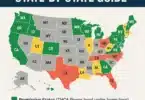Isn’t it enough that fentanyl exists? We’ve got people dropping like flies in the US and beyond, with a lot of these deaths attributable to the extremely powerful opioid. Now it looks like an even more potent opioid, isotonitazene, might make the already awful opioid situation, even worse.
What is isotonitazene?
Isotonitazene – aka Iso – is an opioid drug, derived from benzimidazole, an aromatic organic compound. It’s in the nitrobenzimidazoles chemical classing of opioids, which makes it structurally different than other opioids like fentanyl. This drug is thought to be more potent than fentanyl slightly, and about 2.5X the strength of hydromorphone – often more recognizable under its trade name Dilaudid.
Its said that isotonitazene is 20-100 times more powerful than fentanyl, which is about 100X stronger than morphine (which goes in line with isotonitazene being 500X morphine). One truth is, as very little research exists on the compound, the specifics are unclear. Another truth is, it was not isotonitazene that was originally taken off the street in 2019, but a structural analogue called etonitazene, which has shown to provide 1000X the analgesia level in mice than morphine, but only about 60X the potency level in humans.
Isotonitazene is said to have half the potency of etonitazene, and is expected to have that same discrepancy between animals and people. If the original studies were done on animals, then the 500-1000X stronger than morphine might simply relate to animal studies. Most medical sources say it’s only slightly stronger than fentanyl.
Thank you for being a part of this. Head to the Cannadelics Weekly Newsletter which provides email updates; along with premium offers on cannabis buds, vapes and equipment, edibles, smoking devices, cannabinoid compounds, and plenty more. We should all get stoned responsibly!
Isotonitazene, as an opioid, has similar characteristics to fentanyl and other opioids, in that it relieves pain, as well as providing the same side effects of nausea, itchiness, and the possibility of overdose due to the depression of the respiratory system. On August 20th, 2020, the DEA did something it has so far refused to do with other opioids like fentanyl, and put isotonitazene in Schedule I on the Controlled Substances list.
Why it classified this drug as 100% illegal, and not the ones more currently responsible for the growing number of opioid overdose deaths, is not immediately clear. Though it fits into the opioid class of drugs, its considered a ‘designer drug’ because it’s synthetic; though realistically, all other pharmaceutical opioids (called synthetic opioids) are also therefore technically designer drugs in the same way. So once again, making that designation for this specific compound, and not the others, makes very little sense.
San Francisco responds to isotonitazene
So far, what’s the damage with isotonitazene? A report earlier this month out of San Francisco expressed the thought that this new opioid on the streets of the California city, could greatly exacerbate the current opioid situation. Much like fentanyl, its being found as an addition to heroine and other opioid products, as a means to increase potency; and is used to make fake drugs.
There aren’t good overdose statistics specifically related to the drug yet, which is something authorities are keeping an eye on moving forward. As an opioid stronger than fentanyl, which would boast similar addiction rates, the unfortunate expectation is that deaths should increase proportionally to whatever increase in use it undergoes.
For a city like San Francisco, it’s making authorities nervous, as the city had in the neighborhood of 620 overdose deaths last year, with 72% of them attributed to fentanyl (and, I imagine, other synthetic opioids). This, of course, is representative of the overall growing fatalities related to these drugs in many places.
Said Matt Dorsey, District 6 Supervisor, “I just want to make sure that our city is set up to monitor it and to be testing for it.” He sent a letter to the medical examiner in regards to this, saying, “I just want to make sure that the Office of the Chief Medical Examiner has everything it needs to test for every potential drug that’s costing the lives of anyone in San Francisco.”
Where else is Isotonitazene causing problems?
Opioids might be known most for their damage in America, but the reality is that heroin and synthetic opioids cause problems in many countries, and isotonitazene is now a part of this. Though the article about San Francisco came out in February 2023, Isotonitazene has been causing problems elsewhere in the world already.
One of the interesting things about Isotonitazene is that while it was seen in several cases from 2019 – through 2020, it was replaced by other similar opioids upon the US putting the drug in Schedule I. Perhaps this is an indication that if the US wants to get rid of fentanyl, illegalizing it might help. Not to ignore that isotonitazene incidences were replaced by another similar drug metonitazene; but the situation does indicate that putting the effort into a formal illegalization, could help if there are support services to keep patients from picking up another opioid instead.
A 2021 study called Emerging characteristics of isotonitazene-involved overdose deaths: a case-control study investigated isotonitazene deaths from January 1, 2020 – July 31, 2020, in two locations: Cook County, Illinois and Milwaukee County, Wisconsin. It compared it to other synthetic opioids. In these counties, there were 40 overdose deaths from isotonitazene, and 981 from other synthetic opioids. The study noted that isotonitazene deaths usually occurred with other medications, more frequently than the other synthetic opioids; with particularly large concurrent use of the benzodiazepine flualprazolam.

Another report from UNODC in 2020 said that isotonitazene was only responsible for eight deaths in the US between June 2019 and December 2019. Either these numbers are lower than reality, the ones above are higher than reality, or the drug gained popularity greatly between 2019 and 2020.
The UK is another location where a little data does exist on deaths. According to the Advisory Council on the Misuse of Drugs, Isotonitazene was related to 24 deaths in 2021. In comparison, 2021 saw 2,219 opioid deaths in the UK (about 45% of all overdoses for the year).
A case report out of Switzerland in 2021 identified three different cases of deaths due to Isotonitazene, though in each case it was used with other drugs. In two cases this involved benzodiazepines among other drugs, and one included alcohol.
Right now, the stated cases are the only ones to give death statistics for the drug. Though it seemed to have its glory period between 2019 and 2021, the recent incidence of it in San Francisco signals that it either is coming back, or the article was more a hype piece about a drug that really isn’t seen often. Given the popularity of opioids, and the desire to get more and powerful versions, its not strange to think its making a reappearance.
The opioid epidemic
Opioids have become one of the bigger health concerns, with the largest issues still in the US, though countries like the UK and Canada certainly have their own issues. The choice by British Columbia in Canada to decriminalize all drugs is in direct relation to the growing opioid issue.
Even so, the US is where the meat of the problem is found. From 2019 to 2020 to 2021, overdose rates went from 73,000 to 93,000 to 107,622. And how many of these deaths did opioids account for? While we were never given an estimate for 2021 that I can find, its expected that over 68,000 of the 93,000 from 2020 were opioid-related, and over 48,000 of the 73,000 from 2019 were as well. Following the trajectory, it could be that close to 100,000 deaths in 2021 were from opioids.
It will be time before we have 2022 numbers, but nothing indicates a decrease, and everything indicates an increase. What did come out earlier this year, is New York City data from 2021 on opioid overdoses. 668 lost their lives that year to drug overdoses, and it was established that just fentanyl (minus other synthetic opioids) was responsible for 80% of these. Overdose numbers for 2021 were 78% higher than in 2019. This makes it the most common drug to show up in overdose scenarios, for five years straight.
The problem is so bad, and is so squarely put on the pharmaceutical companies involved, that in February 2022, Johnson & Johnson, AmerisourceBergen, Cardinal Health, and McKesson, offered Native American communities $590 to settle lawsuits against them for their drugs destroying so many communities. On a global level, the payout number was settled at $26 billion for the same companies.

And while they give the ridiculous line that these payouts don’t constitute guilt: Johnson & Johnson quote: “This settlement is not an admission of any liability or wrongdoing and the company will continue to defend against any litigation that the final agreement does not resolve,” the day I see a pharmaceutical company choose of their own volition to give up that much of their profits… well, you see where I’m going with this.
Those lawsuits aren’t even the end of it. That announcement about the $26 billion, came before another settlement with the entire state of Idaho. In this one, the same companies are paying yet another $119 million. And that’s just Idaho, imagine if the rest of the US states did the same. Maybe some are now.
It doesn’t even stop there. For their part in it, the pharmacy companies CVS, Walgreens, and Walmart were up against more than 300 lawsuits for their participation in the opioid game. And as of November 2022, they’re set to pay out $13 billion.
Perhaps the grossest issue of all? The US government, and any government that allows the drugs through regulation; is not only saying this is all okay (despite whatever lines they use to sound otherwise), they’re promoting the problem further. Hell, last year, it came up to lower guidelines for opioid prescriptions. I mean, is there a better way to say the government is complicit? And all this while ketamine has repeatedly shown comparable abilities for pain control, long lasting effects well beyond treatment, and no addiction or real overdose potential.
Conclusion
Do we have to worry about isotonitazene? With the current opioid issue, you better believe it. The one comforting fact, perhaps, is that at least with this one, the US government was smart enough to actually make it completely illegal.
Welcome to the site! Thanks for making it to Cannadelics.com; a news site in the cannabis and psychedelics spaces, bringing you the best stories of today. Pop around frequently to keep in-the-know on related topics, and subscribe to our Cannadelics Weekly Newsletter, to ensure you’re never late to get the news.







